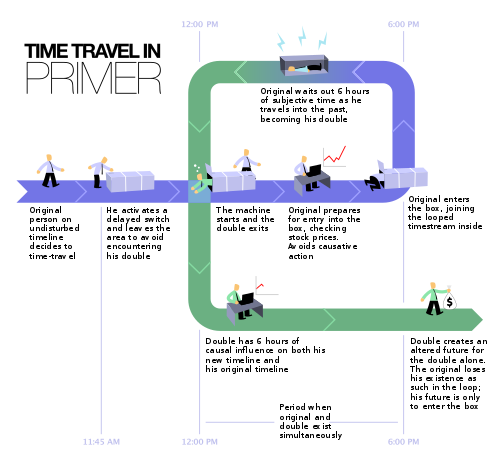 |
| Not one of my diagrams, obviously (thanks XCKD!). |
Some years ago, Shane Carruth's Primer went beyond my plot comprehension skills. The film, about the nightmare that necessarily results from the discovery of time travel as characters go back to the past, creating alternate timeline upon alternate timeline in the process. Primer was a strange movie in that the plotting felt so rock-solid, even though I could hardly tell you what was going on from scene to scene. At one point I resolved to rent the film and spend a weekend poring over it, Zapruder-film style, acetate board in hand, until I understood its secrets. Alas, I discovered that other fans had taken the trouble to do this, and their diagram alone makes me happy I didn't try. For a simpler explanation, this one helps:
 |
| Image by Wikipedia contributor Tom-B, used under Creative Commons License. |
We waited a long time for Carruth's follow up to Primer, Upstream Color. Surprisingly, after the cold, pitiless logic of Primer, Upstream Color is a film that defies diagramming, not because the diagram would be too complicated, but because the logic of the piece is somewhat beside the point. Although I won't reveal spoilers here, this is one of those movies I don't think can be spoiled.
I'll try to do the plot summary justice without revealing too much. In the first few, nearly wordless scenes, Carruth introduces us to some of the mechanics that make Upstream Color's world different than our own. Later, we see Kris (Amy Seimetz), a young woman abused and disgraced by those mechanics. Some years later, a traumatized Kris meets Jeff (Carruth) on her commuter train. Jeff's immediately drawn to her, and as they get to know each other, it becomes clear that the connection between them is not just coincidence. Eventually, the lines of their identities begin to blur in ways that seem first endearing and then frightening. Elsewhere there is a strange pig farmer who collects and makes music from audio samples, and a grove of blue orchids.
If I lost you at "strange pig farmer," don't worry. This movie is a dreamy, elliptical affair which often seems to fold upon and wrap around itself. There are long stretches without dialogue, and what dialogue there is often seems clipped from the middle of a conversation, sending you scrambling to figure out the beginning and the end and how it all fits together. Hang in there. The destination's worth it.
The comparisons that have sprung to every reviewers' mind have been to Terrence Malick, an obvious choice for the beauty of the film's cinematography and the languid stream-of-consciousness approach to plot. Tonally, the film also reminded me of La Jetee, a time travel story that was told in still images that formed the basis/inspiration for 12 Monkeys. Both films put you in a similar state of curiosity, longing to read between the lines.
Seimetz's performance is excellent, and Carruth, while not a great actor by any stretch of the imagination, more than holds his own. One more note: I seldom remark on a movie's sound, but Upstream Color richly deserved the Special Prize it received at Sundance for sound design. I was watching it at home, and it took me only 7 minutes into the film to realize that my TV's crappy speakers weren't going to cut it--I went searching for a pair of hi-fi headphones because i wanted to hear every little bit of this movie.
Upstream Color is very highly recommended. It's also available for streaming on Netflix Watch Instantly. If you subscribe to the service, there's no excuse not to see this film.
No comments:
Post a Comment
Chime in!